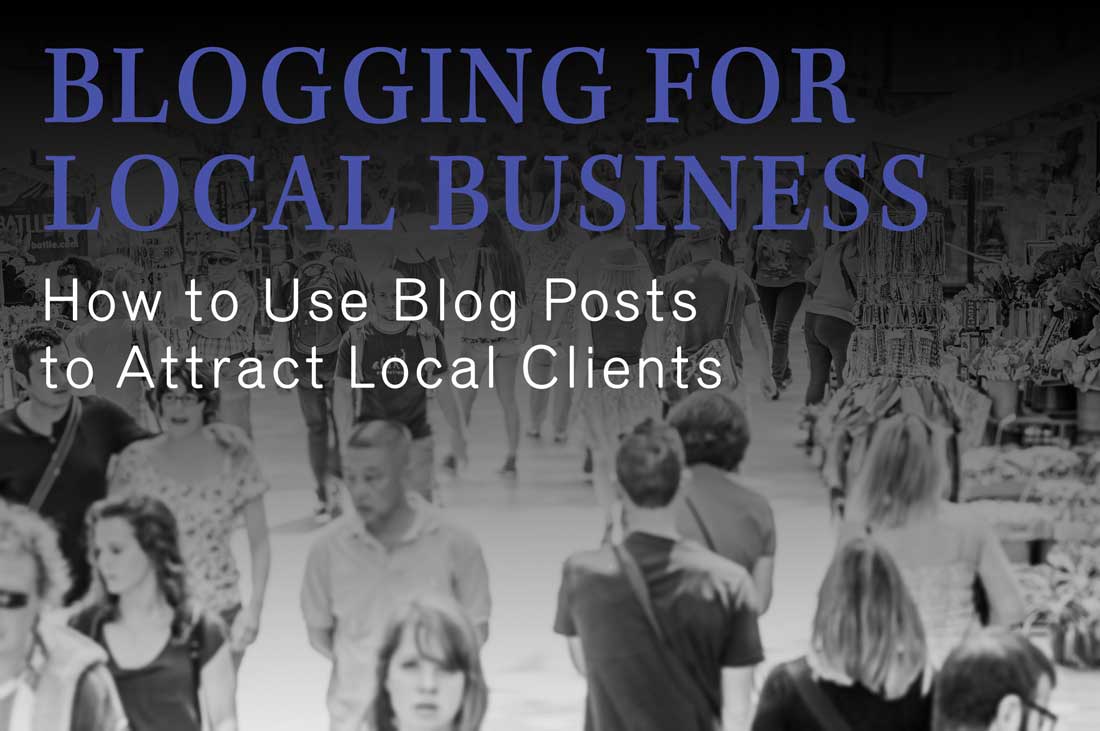Blogging for Local Business: How to Use Blog Posts to Attract Local Clients

Blogging can be the local business owner’s secret marketing weapon. Or it can be a never-ending homework assignment with questionable returns. It all depends on the approach.
There are too many local business owners churning out blog posts for the sake of “fresh content”. They’re speaking to a national audience when only those within a certain geographical area could become clients or customers. They’re frustrated. They give up on blogging because it quickly starts to feel pointless.
Have you had a similar experience? Sorry to hear that. No one has enough spare time to waste untold hours on something that doesn’t produce a tangible result. So how about we take a different approach? After all, blogging for local business is simply not the same as blogging for a national audience.
Blogging is a great marketing tool. And not in some vague, “one day this will pay off” kind of way.
1. It brings traffic to your website. (See below for some details on that.)
2. It demonstrates your expertise once the visitors arrive.
3. It humanizes your business and makes you more accessible.
4. It tells visitors that you’re alive and well and ready to be hired.
5. It helps you make friends around town. (What? Read on.)
The key is to purposely target your local audience.
Step 1. Figure out where your clients and customers are.
If the object is to get eyes on your website, we have to start by asking, “Whose eyes do we want?”. And if the answer is “people who live in your city”, then that’s who should (mostly) be reading your blog.
So what city, county or area are we talking about? Write that down. (Step one is easy. You’re welcome.) Now start writing some articles.
Step 2. Write a blog post that is specific to your city and your customer.
I was speaking to a client the other day who owns a landscape design business. She could fill her blog with beautiful images of gardens to inspire anyone who ends up on her website. She could write how-to’s that will benefit everyone in a temperate climate. These are not terrible ideas. But, because her clients must live within a certain area to hire her, she’s going to be very specific with her posts.
Everyone in her city is freaking out about deer ruining their gardens. So she’s going to write a helpful blog post about how to address that issue and she’s going to call out her city by name in the title of the article. Her readers will click on that headline when it gets shared on social media. Why? Because it’s speaking so directly to them. “I live in that city. Deer are all over my garden.” Click.
Nothing pointless about that. An article that specific and helpful will reach people who:
1. Live in the right area to hire her.
2. Have an interest in keeping their yard looking good.
3. And now, after reading her suggestions, see her as the expert that she is.
And once they’re on her website, they can learn more about her services. If they want to hire her, everything they need is right there. Boom.
Step 3. Make friends around town.
By getting specific with your blog posts, you’re already increasing the likelihood that articles will get shared. But you can multiply your efforts by joining forces with other local businesses.
For the landscape designer, this may mean writing a top five round-up of local exterior house painters and their individual specialties. That’s a perfect compliment to landscape and garden design. Or she could team up with a local interior designer to write an article about how the view of your yard can be improved from the inside of a room. The point is that these fellow business owners become partners in that piece of content. They’ll share it too. Their friends will share it. Go team! It’s beautiful.
How can this apply to your local business? Write a round-up of local sources of (whatever your clients or customers need that relates to your business but you don’t provide). Contact the business owners to let them know they’re being included on the list and/or find out what makes them special. Team up with other business owners who compliment your offerings (but don’t necessarily compete with them) to create content that helps your customer. Include links to their website in the article. Share.
It comes down to this: You can use your blog to create a sense of community.
Step 4. Tell a story.
People love “Before & After” shots. They love heroes and villains and plots that involve insurmountable odds. Tell a story about one of your clients or customers (without revealing any personal details, of course). Connect it to the community so the reader can imagine themselves on a similar journey. Use photos or illustrations when you can.
It can be simple but relate-able. The landscape designer may have a client who moved into a house that was completely surrounded by dirt and dead bushes. There was a huge event planned and they needed to work fast. Would they do it? Could they beat the odds? And, when they did solve the problem, how did they do it? What did the final result look like?
The dry way to say this would be “case study”, but the idea is the same. Find the movie plot in your everyday dealings. It’s there.
Step 5. Offer something intriguing.
Everyone loves free stuff, so let’s talk about ways to use that. You could, for example, run a contest or drawing. Our hero, the landscape designer, could write a blog post about planting bulbs in the Fall with a drawing to win a planting of 100 tulip bulbs. When they bloom in the Spring, she could go take photos and write another blog post about it.
How do people enter? It could be by commenting on the blog post, sharing the article on social media or signing up by using their email address. People will share this and help spread the word for you. The prize just has to be good.
 Step 6. Put it all out into the world.
Step 6. Put it all out into the world.
After you’ve written each post, it’s time to get it out there.
1. Post on social media. Obviously. And, because this stuff is targeting the local market, you may want to share the really good stuff via your personal Facebook account too—not just your business page.
2. Email the link to people who would definitely be interested. You know who they are. This could be a client or two who have expressed interest in the topic or even a friend who just likes tulips/is thinking about repainting their home/whatever the topic is. Ask that they share the post if they know someone who would be interested.
3. Post the link to community boards, social media groups and forums when appropriate. If, for example, you’re running a drawing, there might be a community group or forum that would be interested. If you’ve written an article about addressing the deer problem in gardens in your city, there might be a local gardening group that would be grateful for the free information.
If you’ve created interesting, specific content, people will share it for you. But you have to get it out there.
 In a nutshell: Your clients are local? Start blogging like it.
In a nutshell: Your clients are local? Start blogging like it.
A blog is not a page on your website that needs to be occasionally topped off with pretty images and a more recent publication date. It’s a stage and you choose the show. And if your business only serves locals, your website’s audience should be local too. Use your blog to become a trusted local resource.
Do you have a local business? Did this list give you some interesting ideas? Let’s discuss them in the comments.







Lynne Pearce
| 18 September 2015Great ideas! I found that most of my followers were from England and I live in California ? I should definitely start implementing some of these!